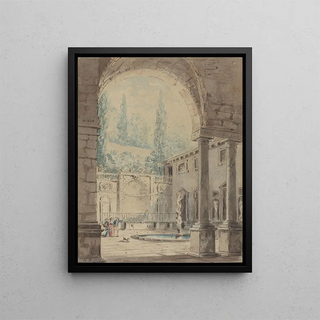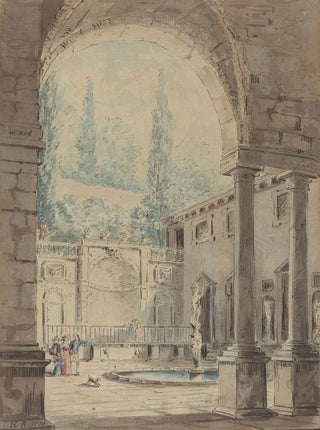Painting Cour de la Villa Pliniana - École de Hubert Robert | Art print


View from behind

Frame (optional)
The "Cour de la Villa Pliniana" is an iconic art print from the School of Hubert Robert, a painting that transports the viewer into a universe where nature and architecture meet harmoniously. This work, both poetic and evocative, invites silent contemplation of the idyllic landscapes of the 18th century. In this depiction, Villa Pliniana, located on the shores of Lake Como, reveals itself under a luminous sky, offering an idyllic vision that reflects the aesthetic aspirations of its time. The soft light bathing the scene seems to caress the ruins, revealing the timeless beauty of the site. The art print of this work allows you to immerse yourself in a world where art and nature intertwine, creating an atmosphere of serenity and dreamlike wonder.
Style and uniqueness of the work
Hubert Robert's style is distinguished by his ability to blend natural elements with classical architecture, while infusing his compositions with an almost romantic dimension. In the "Cour de la Villa Pliniana," the meticulous details of stones and foliage combine to create a striking visual harmony. The chosen colors, from soothing greens to warm ochres, evoke a rich palette that captures the eye and stimulates the imagination. The depth of field, enhanced by carefully controlled perspectives, gives the painting an almost three-dimensional quality, immersing the viewer in a space where time seems suspended. This blend of realism and idealization is characteristic of Robert's work, which manages to capture the very essence of natural beauty while elevating it through human craftsmanship.
The artist and his influence
Hubert Robert, often called the "painter of ruins," established himself as an essential figure in 18th-century French art. His ability to depict landscapes that are both real and imaginary profoundly influenced his contemporaries and paved the way for new artistic movements. Trained at the Royal Academy of Painting and Sculpture, Robert traveled across Europe, absorbing various artistic schools and developing a unique style that marries classicism with a sense

Matte finish

View from behind

Frame (optional)
The "Cour de la Villa Pliniana" is an iconic art print from the School of Hubert Robert, a painting that transports the viewer into a universe where nature and architecture meet harmoniously. This work, both poetic and evocative, invites silent contemplation of the idyllic landscapes of the 18th century. In this depiction, Villa Pliniana, located on the shores of Lake Como, reveals itself under a luminous sky, offering an idyllic vision that reflects the aesthetic aspirations of its time. The soft light bathing the scene seems to caress the ruins, revealing the timeless beauty of the site. The art print of this work allows you to immerse yourself in a world where art and nature intertwine, creating an atmosphere of serenity and dreamlike wonder.
Style and uniqueness of the work
Hubert Robert's style is distinguished by his ability to blend natural elements with classical architecture, while infusing his compositions with an almost romantic dimension. In the "Cour de la Villa Pliniana," the meticulous details of stones and foliage combine to create a striking visual harmony. The chosen colors, from soothing greens to warm ochres, evoke a rich palette that captures the eye and stimulates the imagination. The depth of field, enhanced by carefully controlled perspectives, gives the painting an almost three-dimensional quality, immersing the viewer in a space where time seems suspended. This blend of realism and idealization is characteristic of Robert's work, which manages to capture the very essence of natural beauty while elevating it through human craftsmanship.
The artist and his influence
Hubert Robert, often called the "painter of ruins," established himself as an essential figure in 18th-century French art. His ability to depict landscapes that are both real and imaginary profoundly influenced his contemporaries and paved the way for new artistic movements. Trained at the Royal Academy of Painting and Sculpture, Robert traveled across Europe, absorbing various artistic schools and developing a unique style that marries classicism with a sense
12,34 €






